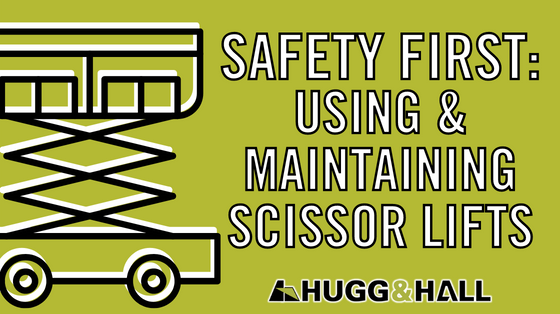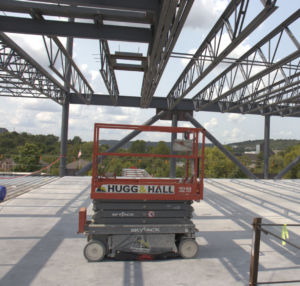
Safety First: Using and Maintaining Scissor Lifts
Scissor lifts are one of the safest options for elevated work, but we still need to talk scissor lift safety.
Fall Protection
In order to prevent injury caused by falls from a platform, OSHA regulations require all scissor lifts to have guardrails. Make sure your workers are properly trained on how to properly secure the guardrail system.
Another way to prevent falls is by properly using safety harnesses. OSHA regulation requires that workers attach a lanyard to their safety harness, which should be anchored to the lift.
Need new safety harnesses for your team? Check out the Hugg & Hall Parts Department.
Scissor Lift Stabilization
Employers need to ensure that all scissor lifts used in the workplace are in stable condition and are not in danger of collapsing or tipping over. Check that all safety systems are in good working order. Be especially careful when driving your scissor lift in order to prevent collisions with other vehicles, stationary overhead obstacles, and ground-level obstacles.
Positioning
Always position scissor lifts in a manner that prevents them from falling or tipping and injuring the operator or others around the lift. Be sure to keep lifts away from power lines and similar hazards to avoid risking injury or death.
Take extra care when operating scissor lifts near fixed objects, other equipment, and when going under overhead obstacles. In-house safety procedures should be implemented and observed to ensure that scissor lifts are always properly positioned and to comply with OSHA’s scissor lift safety requirements.
Controls, Components & Brakes
Inspect and test all controls and instruments on the scissor lift before each shift to ensure that all are in working order and safe for operation. You must set the brakes to keep the scissor lift stable when in use.
Train Your Workers
All scissor lift operators must receive training to operate scissor lifts safely. Training must include:
- Manufacturer’s instructions
- Handling materials
- Weight limits and capacities
- How to work on or around hazards
- How to recognize necessary equipment repairs and maintenance needs
- Preventing accidents.
To learn more, check out this helpful page from OSHA about working safely with scissor lifts.
Have questions about why your scissor lift isn’t working? Check out our blog post about Skyjack errors and quick fixes!
Editor’s Note: Hugg & Hall originally published in July 2022. We updated it updated for freshness, accuracy, and comprehensiveness in March 2023.
Back to News
Subscribe and unlock cutting-edge equipment insights, trends and tips!
Subscribe

